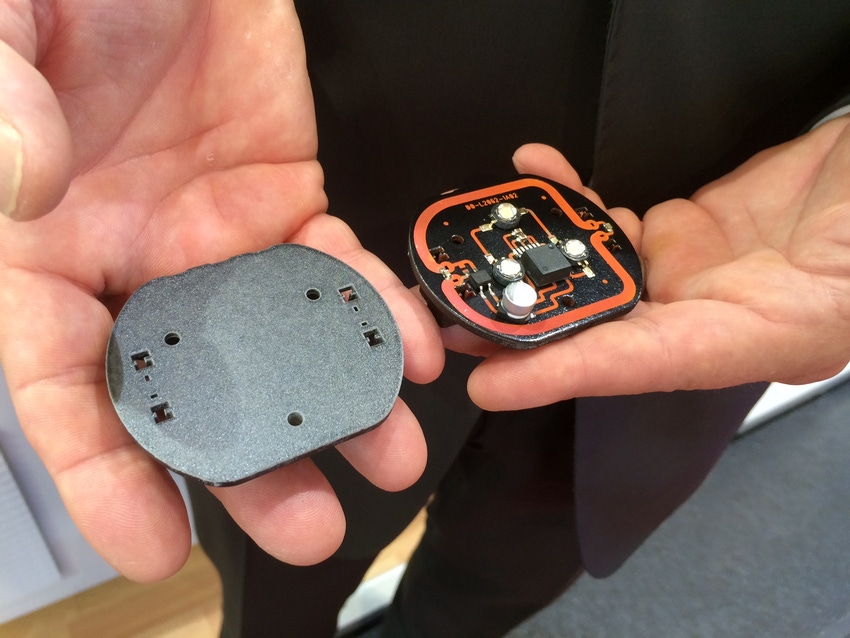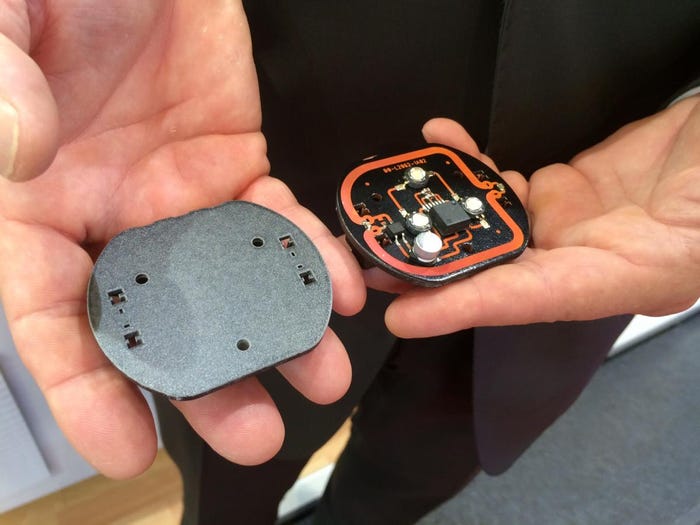At the Fakuma 2014 trade show in Friedrichshafen, among the exhibits at the PolyOne booth was an innovative application of the company's Therma-Tech thermal management compound that looks set to take over the world of three-dimensional molded interconnect devices.
October 21, 2014

At the Fakuma 2014 trade show in Friedrichshafen, among the exhibits at the PolyOne booth was an innovative application of the company's Therma-Tech thermal management compound that looks set to take over the world of three-dimensional molded interconnect devices. In collaboration with the German companies LPKF, specialized in micro-material processing with laser structuring, and plasma treatment and coating expert Plasma Innovations GmbH, PolyOne was showing a novel process for manufacturing LED functional heat sink printed circuit board assemblies based on molded interconnect device technology.
Three-dimensional molded interconnect devices (3D-MIDs) integrate structured conductive circuit tracks on an injection molded plastic part. 3D-MIDs enable the integration of mechanical, electronic, optical and thermal functionality into injection-molded components. Offering new possibilities in design freedom, they have become ubiquitous in virtually every sector of electronics.
 However, in LED lighting assemblies, the challenge has been the need for a heat sink to transfer heat away from LEDs, coupled with a printed circuit board for mounted LEDs. This has generally been addressed by using an aluminum body instead of a plastic one, assembled with a thermal dielectric layer and a LED printed circuit board module. Or, if using a plastic body, by adding a galvanic reinforcement step to the manufacturing process.
However, in LED lighting assemblies, the challenge has been the need for a heat sink to transfer heat away from LEDs, coupled with a printed circuit board for mounted LEDs. This has generally been addressed by using an aluminum body instead of a plastic one, assembled with a thermal dielectric layer and a LED printed circuit board module. Or, if using a plastic body, by adding a galvanic reinforcement step to the manufacturing process.
PolyOne's Therma-Tech material, which is thermally conductive and can also be formulated for electro-conductivity, may eliminate the need for a metal heat sink and moreover, helps cuts out a number of steps in the manufacturing process, as the circuit tracks for the copper wiring can be directly placed on the plastic body.
According to Malte Mussman of Plasma Innovations, "It's a revolution. No galvanic reinforcement. No printed circuit board. And it's 3D, which means a huge design freedom for new lamp designs."
The process is relatively straightforward, said Mussman: "We have the molded Therma-Tech part. Then, we apply a non-stick black lacquer. We then laser out the precise electronic structure on the part. The next step is plasma deposition, which occurs under atmospheric pressure and during which the metal powder melts into a liquid plasma stream and adheres to the lasered-out tracks on the part, while sliding off the lacquered surface of the rest of the part. The metal (copper) can be built up to thicknesses of anywhere between 5 and 100 microns, depending on the voltage needed for the relevant application."
A robot then applies the non-lead solder paste to the LEDS and positions these on the MID. "It goes into the oven, at a temperature of just over 200° Celsius, and then it's done," added Mussman.
PolyOne is "very excited about the technology," according to Anne Hippert, marketing director Europe for PolyOne's Specialty Engineered Materials business unit. "Therma-Tech provides the design freedom that LED manufacturers were looking for together with parts' consolidation and lower assembly costs, and with the thermal management performance of metal. Using our processing knowledge, we are opening up new design applications in a development collaboration with Plasma Innovations and LPKF, helping customers to achieve even greater manufacturing efficiency and simplifying the process of MID and LED production."
About the Author(s)
You May Also Like


